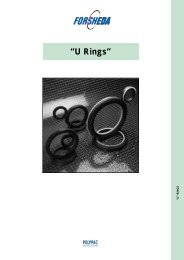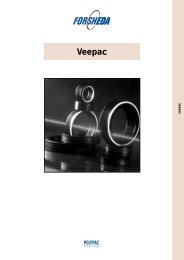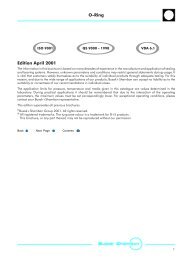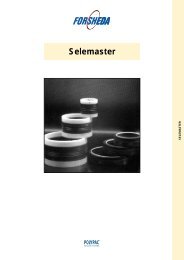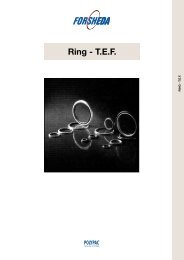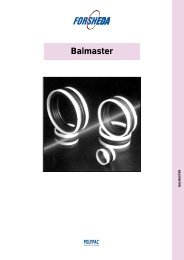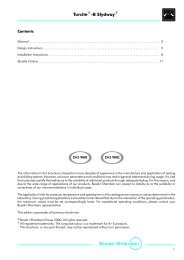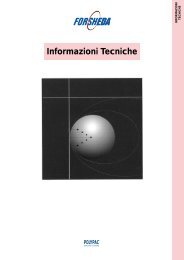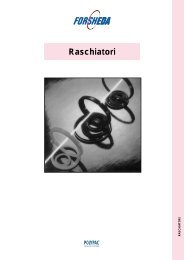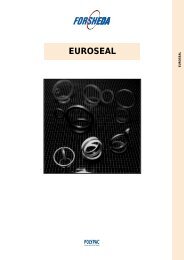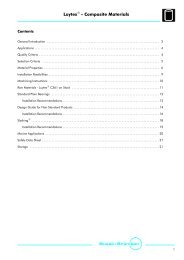Rotary Seals - Dilanda.it
Rotary Seals - Dilanda.it
Rotary Seals - Dilanda.it
You also want an ePaper? Increase the reach of your titles
YUMPU automatically turns print PDFs into web optimized ePapers that Google loves.
Radial Oil Seal<br />
n <strong>Rotary</strong> and axial seal combination<br />
General Description<br />
In many applications rotary shaft lip seals are used to seal<br />
against various mediums.<br />
An important failure mechanism for lip seals is the<br />
destruction of the lubricant film, resulting in rapid wear,<br />
due to the ingress of dirt, dust, moisture etc. The use of<br />
shaft seaIs having one or more auxiliary sealing lips (dust<br />
lips) provides a lim<strong>it</strong>ed improvement, is not always<br />
sufficient. In order to meet the constantly increasing<br />
requirements as to sealabil<strong>it</strong>y - not the least considering<br />
the environmental protection -and long service life the<br />
STEFA COMBI - seal is a simple solution, which has proved<br />
to be particularly well su<strong>it</strong>ed even in cr<strong>it</strong>ical applications<br />
w<strong>it</strong>h heavy contamination. The COMBI-seal consists of a<br />
GAMMA seal and a rotary shaft lip seaI working together.<br />
The lip seal provides the counterface for the GAMMA seal<br />
being fixed to the shaft by press f<strong>it</strong>. See Figure 29 and 30.<br />
Years of successful experiences show that another<br />
frequently used alternative consists in the combination of<br />
aV—Ring seal w<strong>it</strong>h a standard seal selected inside the type<br />
list: TRC/BB; TRD/BC; TRB/DB; TRF/DC.<br />
The rotary shaft seal should be ordered “W<strong>it</strong>hout<br />
Markings“ on the air side.<br />
Radial Oil Seal + GAMMA seal<br />
Figure 30<br />
GAMMA seal f<strong>it</strong>ted on the shaft boss<br />
Radial Oil Seal + V—Ring<br />
The function of the rotary axial seal is to prevent by<br />
centrifugation the intrusion of particles and water drops.<br />
In other words, adds <strong>it</strong>’s original protection capac<strong>it</strong>y to the<br />
radial seal functional<strong>it</strong>y. The necessary cond<strong>it</strong>ion to allow<br />
the application is the space availabil<strong>it</strong>y on the shaft to host<br />
the axial seal width. (See Figure 31).<br />
b<br />
B1<br />
b<br />
Figure 31<br />
V—Ring f<strong>it</strong>ted on the shaft end<br />
Figure 29<br />
GAMMA seal f<strong>it</strong>ted on the shaft end<br />
Housing and shaft design<br />
The radial lip seal needs to be assembled in the housing<br />
according to usual f<strong>it</strong>ting instructions. Both V—Ring and<br />
GAMMA seal is assembled later on the shaft. The shaft<br />
design requires to be adapted by an elongation<br />
corresponding at least to B1 (b) dimension. In case of<br />
very high peripheral speeds, the V—Ring body should be<br />
radially supported. See also the instructions reported in the<br />
specific catalogue chapter.<br />
Latest information available at www.busakshamban.com<br />
Ed<strong>it</strong>ion April 2006<br />
111



